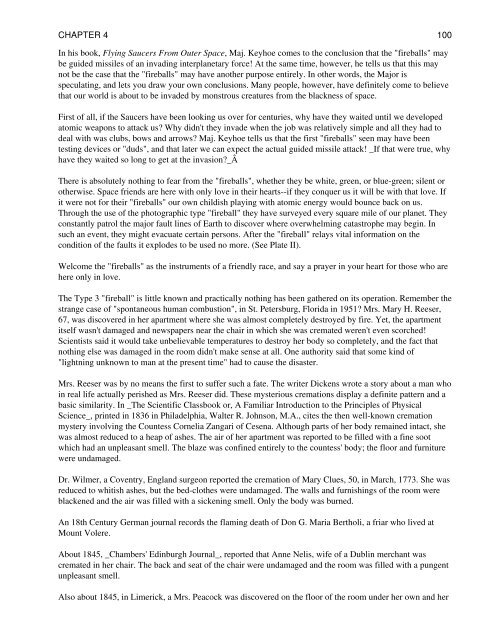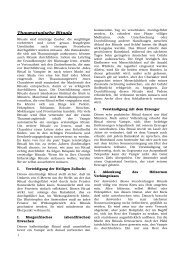CHAPTER 2 CHAPTER 3 CHAPTER 1 CHAPTER 2 CHAPTER 3 ...
CHAPTER 2 CHAPTER 3 CHAPTER 1 CHAPTER 2 CHAPTER 3 ...
CHAPTER 2 CHAPTER 3 CHAPTER 1 CHAPTER 2 CHAPTER 3 ...
Create successful ePaper yourself
Turn your PDF publications into a flip-book with our unique Google optimized e-Paper software.
<strong>CHAPTER</strong> 4 100<br />
In his book, Flying Saucers From Outer Space, Maj. Keyhoe comes to the conclusion that the "fireballs" may<br />
be guided missiles of an invading interplanetary force! At the same time, however, he tells us that this may<br />
not be the case that the "fireballs" may have another purpose entirely. In other words, the Major is<br />
speculating, and lets you draw your own conclusions. Many people, however, have definitely come to believe<br />
that our world is about to be invaded by monstrous creatures from the blackness of space.<br />
First of all, if the Saucers have been looking us over for centuries, why have they waited until we developed<br />
atomic weapons to attack us? Why didn't they invade when the job was relatively simple and all they had to<br />
deal with was clubs, bows and arrows? Maj. Keyhoe tells us that the first "fireballs" seen may have been<br />
testing devices or "duds", and that later we can expect the actual guided missile attack! _If that were true, why<br />
have they waited so long to get at the invasion?_Â<br />
There is absolutely nothing to fear from the "fireballs", whether they be white, green, or blue-green; silent or<br />
otherwise. Space friends are here with only love in their hearts--if they conquer us it will be with that love. If<br />
it were not for their "fireballs" our own childish playing with atomic energy would bounce back on us.<br />
Through the use of the photographic type "fireball" they have surveyed every square mile of our planet. They<br />
constantly patrol the major fault lines of Earth to discover where overwhelming catastrophe may begin. In<br />
such an event, they might evacuate certain persons. After the "fireball" relays vital information on the<br />
condition of the faults it explodes to be used no more. (See Plate II).<br />
Welcome the "fireballs" as the instruments of a friendly race, and say a prayer in your heart for those who are<br />
here only in love.<br />
The Type 3 "fireball" is little known and practically nothing has been gathered on its operation. Remember the<br />
strange case of "spontaneous human combustion", in St. Petersburg, Florida in 1951? Mrs. Mary H. Reeser,<br />
67, was discovered in her apartment where she was almost completely destroyed by fire. Yet, the apartment<br />
itself wasn't damaged and newspapers near the chair in which she was cremated weren't even scorched!<br />
Scientists said it would take unbelievable temperatures to destroy her body so completely, and the fact that<br />
nothing else was damaged in the room didn't make sense at all. One authority said that some kind of<br />
"lightning unknown to man at the present time" had to cause the disaster.<br />
Mrs. Reeser was by no means the first to suffer such a fate. The writer Dickens wrote a story about a man who<br />
in real life actually perished as Mrs. Reeser did. These mysterious cremations display a definite pattern and a<br />
basic similarity. In _The Scientific Classbook or, A Familiar Introduction to the Principles of Physical<br />
Science_, printed in 1836 in Philadelphia, Walter R. Johnson, M.A., cites the then well-known cremation<br />
mystery involving the Countess Cornelia Zangari of Cesena. Although parts of her body remained intact, she<br />
was almost reduced to a heap of ashes. The air of her apartment was reported to be filled with a fine soot<br />
which had an unpleasant smell. The blaze was confined entirely to the countess' body; the floor and furniture<br />
were undamaged.<br />
Dr. Wilmer, a Coventry, England surgeon reported the cremation of Mary Clues, 50, in March, 1773. She was<br />
reduced to whitish ashes, but the bed-clothes were undamaged. The walls and furnishings of the room were<br />
blackened and the air was filled with a sickening smell. Only the body was burned.<br />
An 18th Century German journal records the flaming death of Don G. Maria Bertholi, a friar who lived at<br />
Mount Volere.<br />
About 1845, _Chambers' Edinburgh Journal_, reported that Anne Nelis, wife of a Dublin merchant was<br />
cremated in her chair. The back and seat of the chair were undamaged and the room was filled with a pungent<br />
unpleasant smell.<br />
Also about 1845, in Limerick, a Mrs. Peacock was discovered on the floor of the room under her own and her






